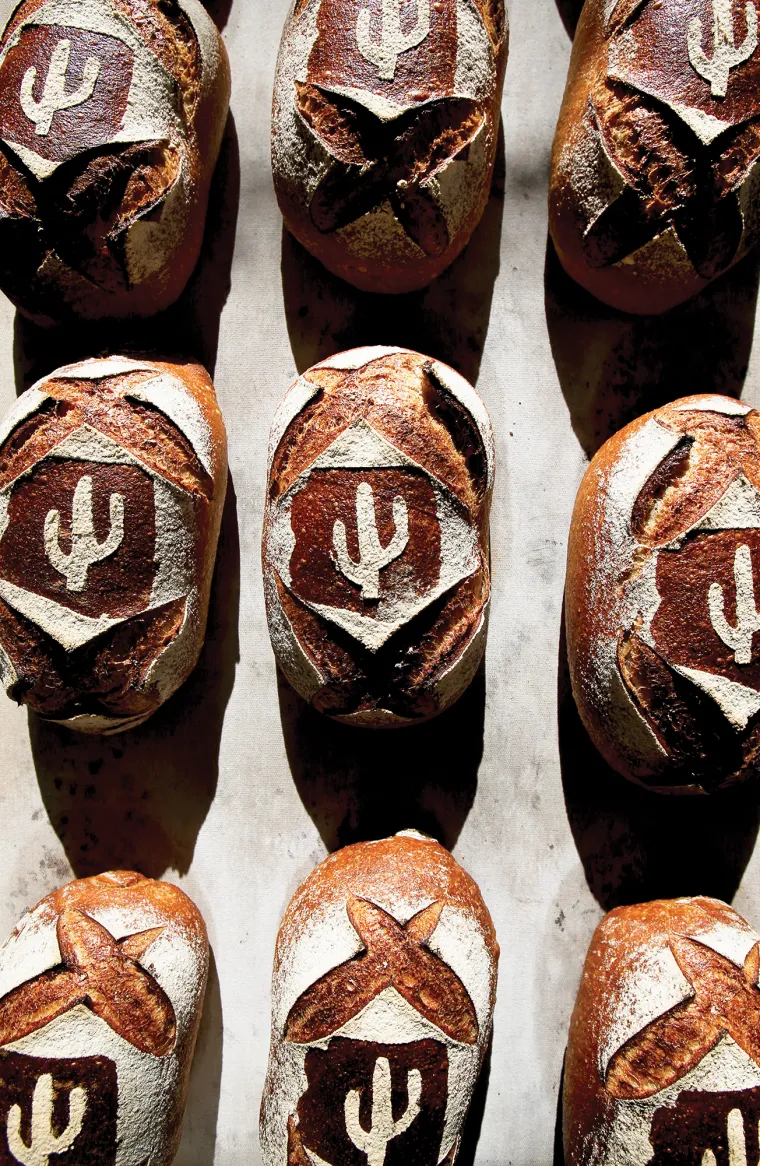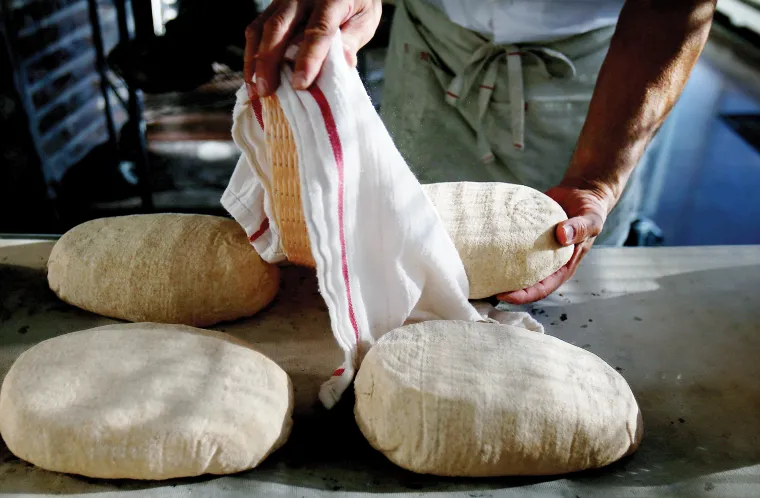For the Love of Bread
The artistry of baking great grains

Don Guerra '01
Only the rim of the sun is visible over the Rincon Mountains when Don Guerra ’01 begins loading the first batch of bread into his Italian deck oven. He has been at his Barrio Bread bakery in historic Broadway Village since 5 a.m. Each of these loaves, which he calls his Super Seed bread, has spent the 12 overnight hours nestled in a terrycloth towel in a wicker basket as it slowly rose in the fermentation chamber, a large refrigerator kept at 42 degrees. Next to go into the oven are the Rustic Nine Grain loaves, which he carefully unwraps from the French linen towels where they spent the night. They are the first of the 600 loaves he will bake that day in an oven that customers can see in the front of the store.

Guerra graduated from the UA College of Education in 2001 and taught health and physical education at an elementary school in Tucson. Although he loved being a teacher and was recognized with awards, his earlier experience as a baker in both Flagstaff and Oregon kept calling him back. In 2009 he followed his heart and set up a bakery in the two-car garage at his home. He also plunged into experimentation with the local heritage grains that give his bread such rich flavor.
“As an artisan baker, these grains have opened up my world tremendously,” Guerra says as he slides the third tray of 15 loaves into the oven. “It’s not the shape or the flavoring. It’s about the grain itself. Like an artist that blends paints, I blend grains to produce the color and the flavor profile of the bread. It’s that innovation that keeps me excited. It’s just flour, water and salt, but it’s how you combine them that is key.”
To source the specialty grains essential to his bread, Guerra works with the Wong family at BKW Farms just up the highway in Marana. In addition to planting their usual crops, they support Guerra’s mission by growing small plots of spelt, white Sonora wheat, einkorn (the most primitive form of wheat), and Khorasan (also called kamut), an ancient form of durum wheat from Iran. They also supply Guerra with organically grown durum and hard red spring wheat, the more modern varieties.
“BKW and I have an awesome collaboration,” Guerra says. “We are working on developing a local grain economy. Some of these varieties were in danger of disappearing, but through our partnership we have an opportunity to change the course of history.”
Guerra’s method of producing bread is costly. His flour costs 50 percent more than commodity flour and each loaf takes 24 hours from flour to fragrant brown goodness. This is reflected in his prices, but there are plenty of people who see the value in his exceptional product and are willing to pay.
During the eight years Guerra worked out of his garage bakery, he sold his bread out of the trunk of his car, at a farmers market, at schools and through a Community Supported Agriculture group. People could go online to reserve a loaf or two for pickup; those who had not ordered in advance would get to the distribution centers early, join the lines and take their chances.
During those years, Guerra was constantly thinking through the details of running a storefront bakery again. He had begun saving funds for the move, but his plans took a leap forward when he won a $100,000 USDA Local Food promotion grant. As part of Guerra’s grant proposal, he vowed to operate using 20 percent local grains in the first year of operation. His bread already contains about 50 percent grain from local sources.
The grant gave him the capital to set up his small retail store and also the flexibility to hire staff so he can spend time away from his bakery, educating the community on the importance of heritage grains.
Guerra calls himself a community baker. When he isn’t baking, he is sharing his passion, spreading the word about heritage grains. This educating — this sharing that he does constantly — is as important to Guerra as the flavorful golden loaves with the deep brown crust that he turns out five days a week. He is an energetic speaker and always arrives with arms full of his delicious loaves that he passes out at the end of the session. Adventurous bakers can take home a portion of his wild yeast starter to put Guerra’s lessons into immediate use.
“I’ve taught 600 people how to bake the way I do,” he says. “I did a series through UA outreach. I taught in the social entrepreneurship class at the Eller College of Business and lectured to a physics class on the physics of bread.”
Now, with a proper store, Guerra is moving his popular, always-sold-out classes under his own roof — and further afield. He’s going to Taiwan for the second time to teach his business model of community-supported small-scale baking with local grain through National Taiwan University’s Bread without Borders initiative.
In late October, he will travel to Seattle to lecture to the Bread Bakers Guild of America on how to start a community-supported bakery. He has already been recognized by his peers, having been named one of the Top Ten Bakers in America by Dessert Professionals magazine last year.
Guerra credits his education degree with his success. “My work in the College of Education prepared me not only for teaching but also for life,” he says. “I’m still in education, but teaching my favorite subject — bread. You don’t leave your tribe.”
Guerra doesn’t worry about competition from all the people who learn his methods. “There are no shortcuts in this business,” he says. “If they are able to pull it off and go out and do it for themselves, great.”
“I work a hundred hours a week, but I’m trying to create a sustainable future for the community. If I don’t teach these folks to make bread, who will be our bakers in the future?”




